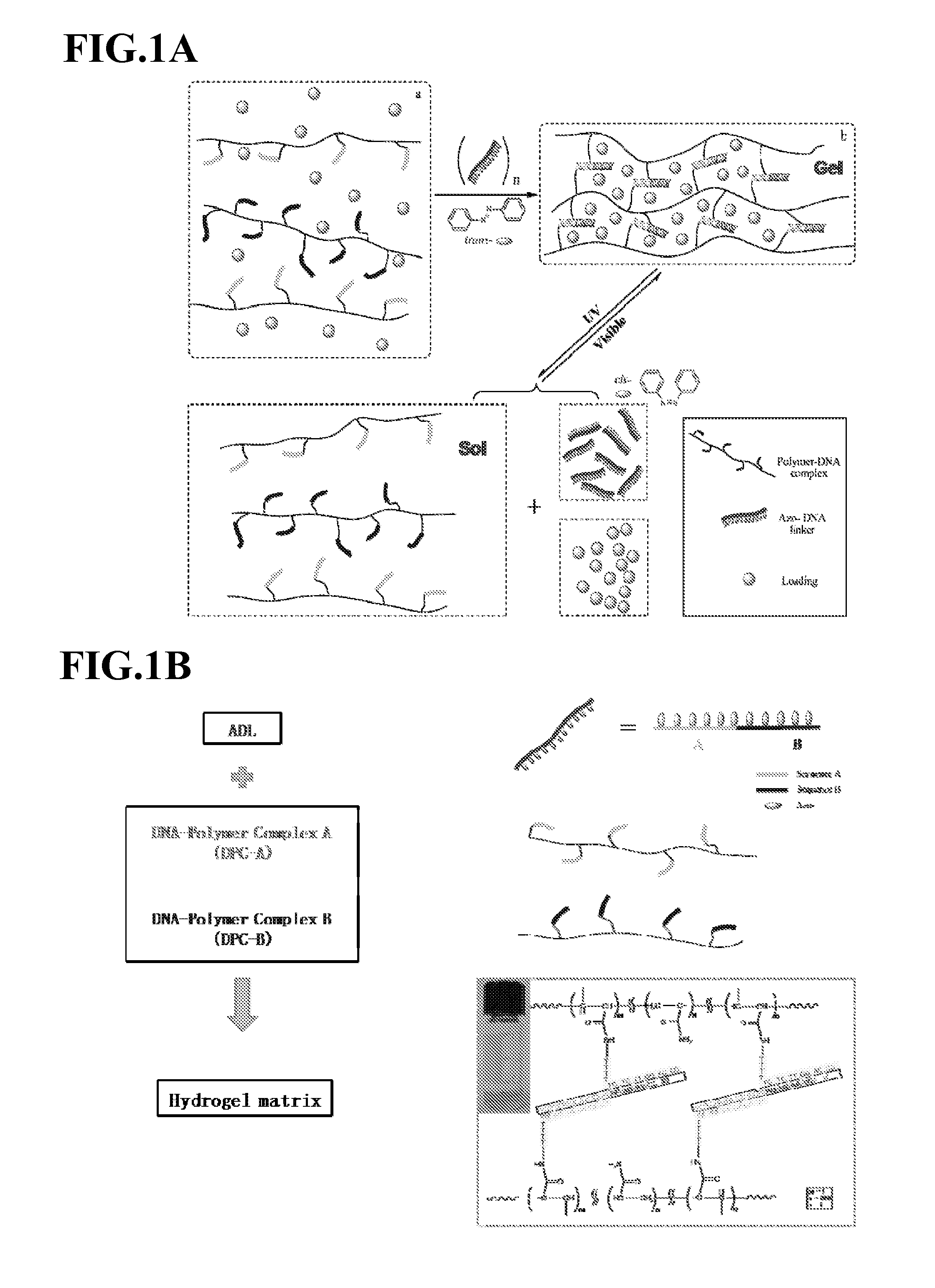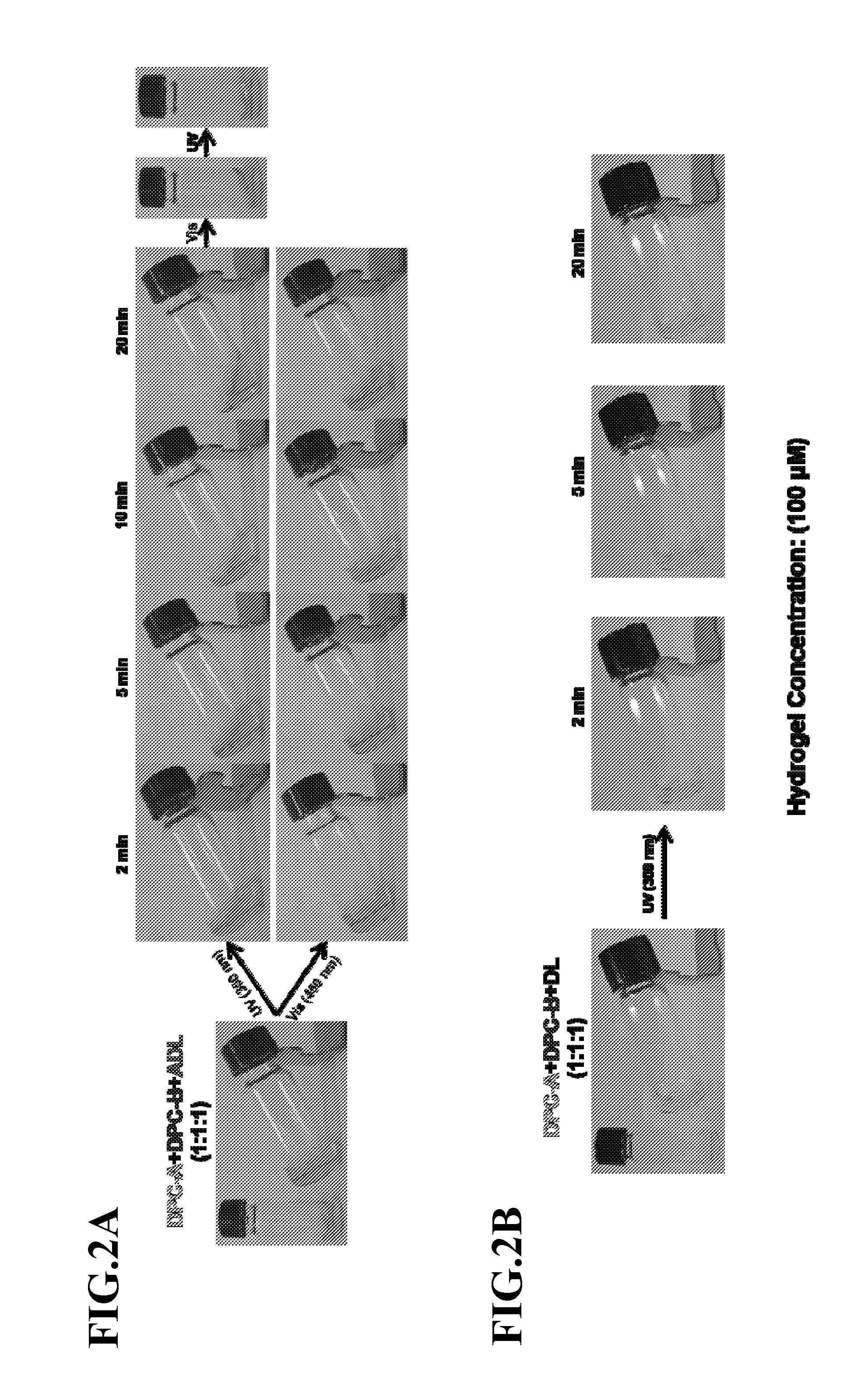Photoregulated Reversible Hydrogels for Delivery and Releasing of Drugs and Other Therapeutical Reagents
a technology of reversible hydrogels and drugs, which is applied in the field of photoregulated reversible hydrogels for delivery and releasing of drugs and other therapeutical reagents, can solve the problems of unsatisfactory system or method of localized irradiation, and no combination of dna and dna-polymer conjugates to create photoregulated dna crosslinked hydrogels. , to achieve the effect of excellent spatial resolution, high
- Summary
- Abstract
- Description
- Claims
- Application Information
AI Technical Summary
Benefits of technology
Problems solved by technology
Method used
Image
Examples
example 1
Design of Photocontrollable DNA Crosslinked Hydrogel
[0056]DNA linker (ADL or DL), DPC-A and DPC-B were mixed in stoichiometric 3 mM DNA concentrations in Tris buffer (10 mM Tris (pH 8.0), 50 mM NaCl, 10 mM MgCl2). Crosslinked hydrogels (yellow color) or DL crosslinked hydrogel (colorless) were formed immediately after mixing. All hydrogels were treated for 10 minutes of incubation at 50° C. before tests. Other concentrations of hydrogels were prepared with direct dilution with buffer solution followed with annealing and visible light irradiation. UV light (˜350 nm) can photoisomerize the azobenzene moieties to cis-state, while visible light (˜450 nm) can switch the conformation back to the trans-state. The isomerization of Azo- is capable of regulating the hybridization between two complementary strands, whereby the trans-state can stabilize the hybridization, and the cis-state can destabilize it. An Azo-incorporated DNA strand was designed which serves as a photoresponse crosslinke...
example 2
Photocontrollable Sol-Gel Conversion and Reversibility
[0059]The gel-sol conversion and its reversibility were investigated through repeated UV and visible light irradiations. The prototype ADL crosslinked hydrogel was prepared by directly mixing ADL, DPC-A and DPC-B in stoichiometric concentration with 3 mM concentration hydrogel based on DNA quantity. At this concentration, the yellow hydrogel was observed as a robust gel with high viscosity. The stiffness could maintain the gel state without obvious gravitational effect similar to solid materials. The initially formed 3 mM hydrogel could be homogeneously diluted to other concentrations by annealing at 50° C. with buffer solution. These were used to investigate concentration-dependent properties, such as photo-sensitivity, efficiency of encapsulation and release. The reversible photoconversion was demonstrated with a 300 μM ADL hydrogel from dilution. This hydrogel was first irradiated by visible light and then treated with either ...
example 3
Photocontrollable Encapsulation and Release of Diverse Loads by Hydrogels
[0062]To demonstrate the photon-triggered release of loads from the photosensitive ADL crosslinked hydrogels, a series of ADL crosslinked hydrogels with different concentrations were prepared to explore the controllability. Only the factor of hydrogel concentration relative to encapsulation and release of different loads was focused, with other conditions unchanged. The entire initial doping process can be achieved by simply mixing the loads with sol-state hydrogels by either heating or UV light irradiation under stirring, followed by cooling and visible light irradiation for loading in the gel.
[0063]The encapsulation capability based on stability and immobility is related to the hydrogel matrix. To determine individual particle entrapment by physical size and interaction, the term “cage” was defined to represent the hydrogel network pore size. The size of the cage is estimated by the chain lengths on a regulat...
PUM
| Property | Measurement | Unit |
|---|---|---|
| temperature | aaaaa | aaaaa |
| pH | aaaaa | aaaaa |
| power meter | aaaaa | aaaaa |
Abstract
Description
Claims
Application Information
 Login to View More
Login to View More - R&D
- Intellectual Property
- Life Sciences
- Materials
- Tech Scout
- Unparalleled Data Quality
- Higher Quality Content
- 60% Fewer Hallucinations
Browse by: Latest US Patents, China's latest patents, Technical Efficacy Thesaurus, Application Domain, Technology Topic, Popular Technical Reports.
© 2025 PatSnap. All rights reserved.Legal|Privacy policy|Modern Slavery Act Transparency Statement|Sitemap|About US| Contact US: help@patsnap.com



